Author: Hai Se Tian Hen
Editor: Deng Chu Han
There is a new field of medicine called “regenerative medicine,” which focuses on how to regenerate damaged parts of the human body.
Currently, this technology has advanced to the point where it can print blood vessels, bones, ears, etc. The hope is that in the future, it will be possible to do things like this—if a tooth is damaged, stem cells can grow a new one; if there are blood issues, umbilical cord blood can produce a batch; if the heart, liver, spleen, lungs, or kidneys fail, we can print a brand new one to replace it…
Of course, the reproductive system is also one of the key research areas in regenerative medicine.
Not long ago, scientists completed an artificial uterus using plastic bags.

The artificial uterus nourished premature lambs and will shelter human infants. Animation source: Nature Communications
Now, scientists from Northwestern University in the United States are making headlines again, with their paper published in Nature Communications on May 16. Their new discovery is—
a brilliantly glowing fluorescent mouse!
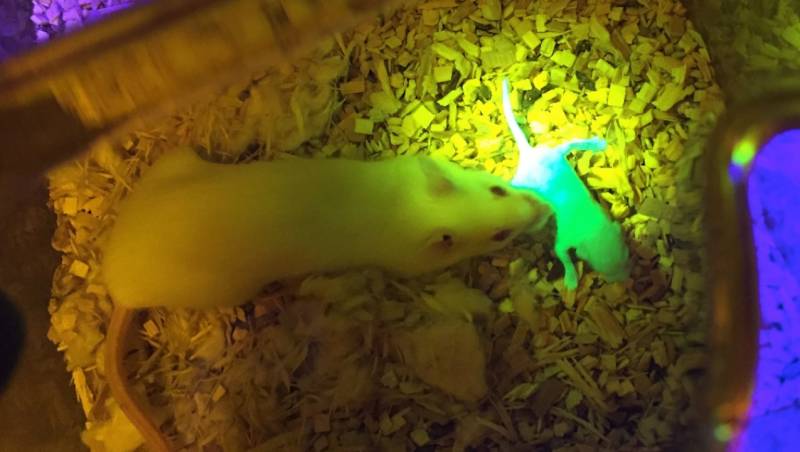
Are scientists doing gene editing again?
Yes, but what’s so surprising about that?
Well, this mouse was born from a 3D printed ovary.
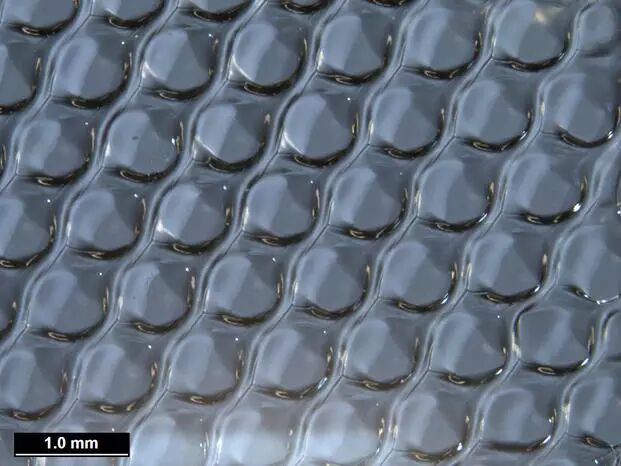
You might not believe it, but this is what the printed ovary looks like under a microscope.

Printing Technology of Mouse Ovaries

This time, the scientists attempted to create a mouse ovary.
1
Extracting the Mouse Ovary
They removed the mouse’s ovary, sterilized it, preserved the ovarian tissue, and isolated the follicles and hormone-producing cells. These cells can support immature eggs.
2
Basic Structure of the 3D Printed Ovary
One technical breakthrough of this research was finding the “skeleton” of the ovary and using gelatin to print the ovary scaffold.
Gelatin is a biomaterial that makes up our soft tissues. Most hydrogels are fragile, but gelatin can support itself, forming the three-dimensional support structure necessary for egg maturation.
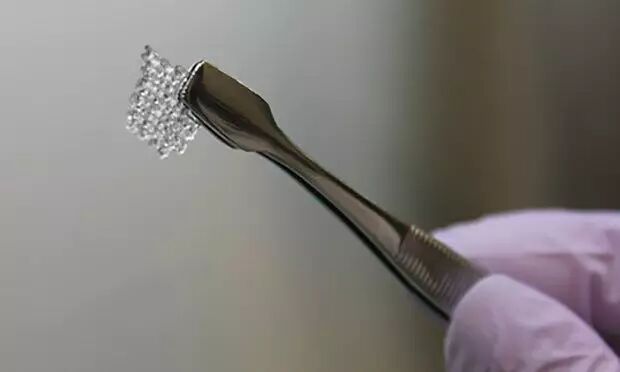
3D printed ovary structure: a 15mm x 15mm gelatin scaffold layer.
Then, 40 to 50 follicles and hormone-producing cells supporting the follicles were added to the ovary.
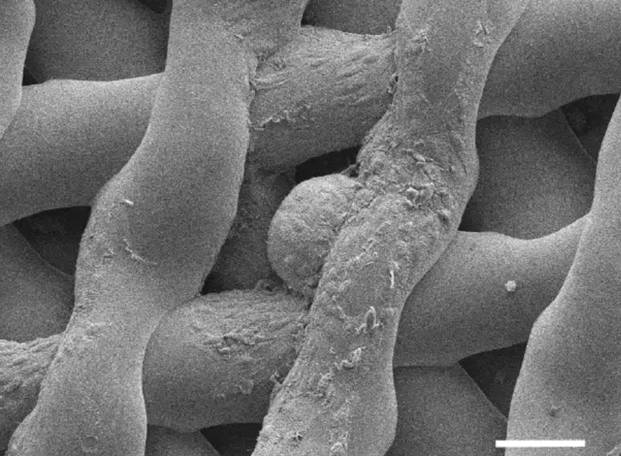
Immature mouse oocytes under a microscope, surrounded by supporting cells and a gelatin scaffold.
The final ovary structure must have sufficient strength to withstand surgery; it must be porous enough to integrate with the mouse’s body tissue. Additionally, the weaving pattern of the gelatin scaffold is crucial, directly affecting the survival rate of the follicles within it.
3
Transplanting the Ovary Back into the Mouse
The printed ovaries were transplanted back into the bodies of seven mice, and within a week, these ovaries received blood supply from the mice. The eggs in the new ovaries could gradually mature and eventually ovulate.
Ultimately, three out of the seven mice with the new ovaries produced normal eggs and became pregnant, giving birth to healthy pups.
The eggs of these pups had previously undergone gene editing to emit green fluorescence. This ensured that the pups born were indeed from the 3D printed new ovaries, rather than residual ovaries from the mice.
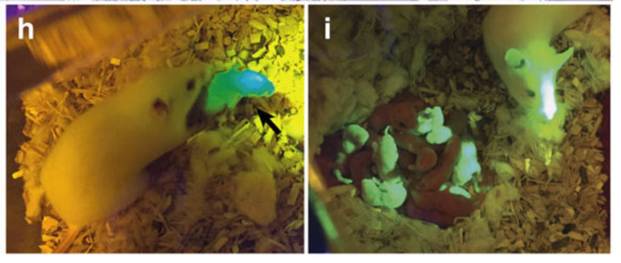
The pups that emit green light are from the 3D printed new ovaries.
Moreover, these printed ovaries also secrete hormones normally, which are delivered through the blood circulation to various parts of the mouse’s body. These hormones support the mouse’s normal physiological responses during pregnancy and lactation.

Research Team Behind the Technology

What kind of team can come up with such groundbreaking ideas and actually realize them?
Answer: Experienced, and all female!
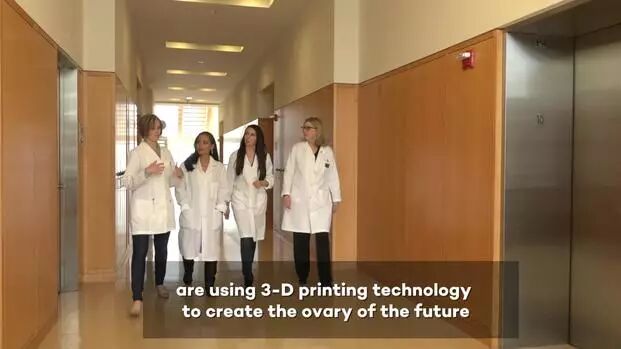
Research Team
One of the authors of this research, Teresa Woodruff, stated: We hope that this technology can help women who wish to regain fertility in the future.
Some young women who have cancer can have some ovarian tissue removed and preserved before chemotherapy or radiotherapy, isolating the follicles. Once the cancer is cured, a new printed ovary can be placed back.
Additionally, this technology can help not only women regain fertility. The ovary is an important endocrine organ, and implanting a new ovary can also alter a woman’s endocrine system. Therefore, for some women with hormonal imbalances, implanting an ovary can make them healthier. A 2010 study in Japan found that implanting ovaries into elderly female mice that had lost fertility extended their lifespan by 40%.

Other Experiments by This Team

In fact, Woodruff’s lab has conducted many sci-fi-like reproductive system studies.
1
In vitro development of human immature eggs
Don’t underestimate this research. Many female cancer patients want to preserve their eggs before chemotherapy or radiotherapy. However, only one egg matures in a woman’s body each month. If they want to store more of their eggs, they must undergo 2 to 6 weeks of hormone treatment to stimulate a batch of eggs to mature. Sometimes one round is not enough… And cancer patients may not have that much time to wait. Moreover, if they have breast or ovarian cancer, hormone treatment may worsen their condition.
If immature eggs could develop to maturity in vitro, then there would be no need to wait, and thousands of egg cells could be extracted at once for freezing.
They could have gone further—such as testing whether these eggs could be fertilized and develop normally, but funding limitations prevented that.
2
In vitro micro-model of the female reproductive system
This model includes ovaries, fallopian tubes, and other reproductive organs, directly simulating the human 28-day menstrual cycle.
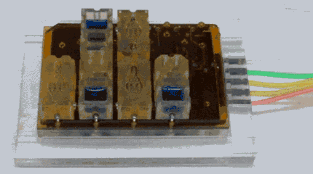
It looks like Lego blocks, but this is indeed a miniature model of the reproductive system.
The purpose of this research is to create an in vitro model, establishing a testing platform for drugs or theories.
Why create an in vitro model?
Because testing directly on humans or donated human organs would be too costly, using only human cells for testing cannot fully reflect the complex responses in the body, and testing on animals has its differences from humans.
Returning to the research on printing ovaries. The next step, they plan to conduct experiments on pigs. Because human ovaries are much larger and structurally more complex than mouse ovaries, the reproductive system of pigs is closer to that of humans, which will prepare for human experiments.
Finally, the question you are most concerned about: When can we print human ovaries?
Woodruff stated: Within ten years, it may be possible to print human ovaries!
-
The artificial uterus nourished premature lambs and will shelter human infants.
-
How to create an artificial uterus?
-
Using pigs to cultivate human organs, and they can be transplanted to newborns with congenital defects!
-
Ten human organs that can survive without, the first one is…
References:
Monica M. Laronda, Alexandra L. Rutz, Shuo Xiao, Kelly A.Whelan, Francesca E. Duncan, Eric W. Roth, Teresa K. Woodruff, Ramille N.Shah. (2017). A bioprosthetic ovary created using 3D printed microporous scaffolds restores ovarian function in sterilized mice. Nature Communications, Article number: 15261 (2017). doi:10.1038/ncomms15261
Paoletta, R. (2017). These Mice Gave Birth Using 3D-Printed Ovaries. Gizmodo UK. http://www.gizmodo.co.uk/2017/05/these-mice-gave-birth-using-3d-printed-ovaries/
Jason Daley. (2017). Mice With 3D-Printed Ovaries Successfully Give Birth. Smithsonian. http://www.smithsonianmag.com/smart-news/functional-3d-printed-ovary-transplanted-mice-180963337/
Sample, I. (2017). 3D-printed ovaries allow infertile mice to give birth. the Guardian. https://www.theguardian.com/science/2017/may/16/3d-printed-ovaries-allow-infertile-mice-to-give-birth
Sample, I. (2010). Ovary transplants could extend women’s lifespan, mice study suggests. the Guardian. https://www.theguardian.com/science/2010/jun/29/ovary-transplants-women-lifespan-mice
The World’s First ‘Period’ in a Dish Could Revolutionize Reproductive Medicine, (2017). Gizmodo.com. http://gizmodo.com/the-worlds-first-menstrual-period-in-a-dish-could-revol-1793684158
A Fertility First: Human Egg Cells Grow Up in Lab.(2009). Wired.com. https://www.wired.com/2009/07/humanegg/
An AI

Guokr.com
“Is this Guokr?”
—Of course it is!
In the 【Portal】 at the bottom of the public account,
there are more amazing contents~~

This article is from Guokr.com, reproduction is prohibited.
If needed, please contact [email protected]
(Feel free to share to your circle~)